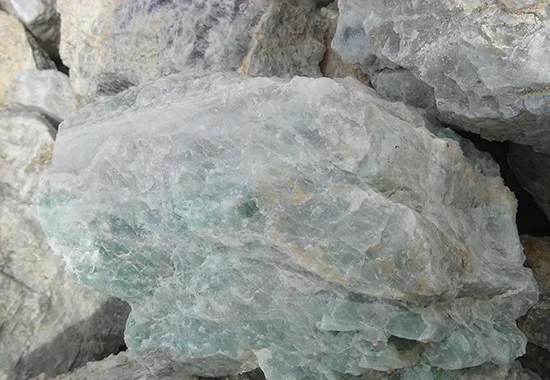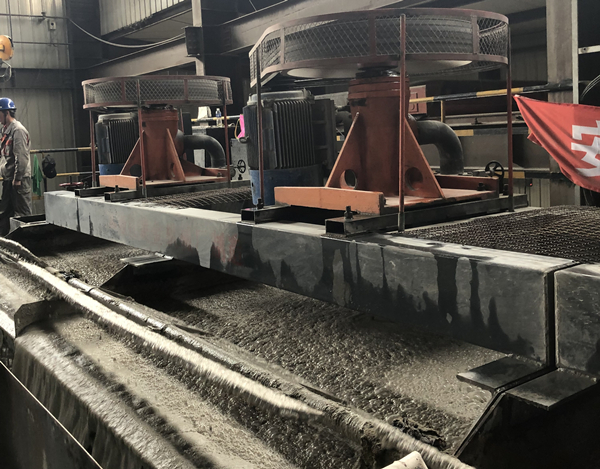Quartz-type fluorspar primarily consists of fluorspar and quartz, with fluorspar content around 85%. It also contains small amounts of calcite, barite, and sulfides, making it a difficult-to-select fluorspar ore. The formation of this type of ore is attributed to ore-bearing hydrothermal fluids condensing in fractures of siliceous rocks. So, how should one process this challenging quartz-type fluorspar ore? What is the specific process flow?

The processing of this type of ore often involves a staged grinding and flotation approach, with a typical process flow consisting of rough crushing and coarse selection, followed by regrinding of the rougher concentrate and multiple stages of cleaner flotation.
The primary focus when treating such ores is to reduce the silica content in the concentrate. The required silica content can vary depending on the specific usage. In the ore processing process, grinding is a significant factor affecting the flotation of quartz-type fluorspar ore, and it is necessary to liberate fluorspar from quartz during the grinding stage.
Since quartz-type fluorspar ores often contain intergrowths of quartz and fluorspar, overly fine grinding can lead to overgrinding of fluorspar, which affects recovery rates. Therefore, it is common to use staged grinding processes, which not only reduce the silica content in the fluorspar concentrate after flotation but also increase the recovery of fluorspar. By employing staged grinding and flotation, a high-grade fluorspar concentrate can be obtained.

Quartz-type fluorspar ores typically contain a significant amount of quartz and a small amount of fluorspar, making the ore beneficiation process relatively complex. Here are the general steps for processing difficult-to-select quartz-type fluorspar ore:
Ore Crushing: Initially, the raw ore is subjected to primary crushing using crushing equipment to reduce the particle size. Typically, jaw crushers are used for coarse crushing, while cone crushers are used for medium and fine crushing.
Ore Grinding: The crushed ore is then sent to a grinding mill to further reduce the particle size. This helps release the valuable minerals in the ore. It is important to select the appropriate grinding process based on the ore's mineral properties to achieve the separation of fluorspar from quartz gradually.
Fluorspar Flotation: The ore is subjected to flotation to separate the fluorspar from the ore. During the flotation process, the ore is mixed with water, and one or more fluorspar collectors, such as oxalic acid or nitric acid, are added. The fluorspar particles are then floated to the surface with the help of bubbles and can be collected.
Silica Removal: Since quartz is a significant component in quartz-type fluorspar ore, it needs to be further processed to remove silica. Chemical leaching methods, such as hydrofluoric acid leaching or sodium hydroxide leaching, are typically used to remove the silica.
Desliming: The ore may contain clay and other impurities that need to be removed. Various methods, including sedimentation tanks and cyclone separators, can be used to remove these impurities.
Fluorspar Concentrate Processing: Through further flotation and processing, high-purity fluorspar concentrate can be produced to meet specific application requirements.
These steps can be adjusted based on the specific ore composition and processing requirements. Processing difficult-to-select quartz-type fluorspar ore often requires time and resources, so careful process planning and optimization are essential to improve extraction efficiency and reduce production costs.

In a specific case, the original ore had a CaF2 grade of 17.32% and was a quartz-type fluorspar ore. Using a self-made low-temperature collector DW-1 at a temperature of 6°C, the ore was processed using a flotation process with a "1st roughing, 1st scavenging, and 6 stages of cleaning, with middlings returning" flow sheet.
The results showed excellent performance, with a fluorspar concentrate having a CaF2 grade of 98.37% and a recovery rate of 80.12%. This flotation effect outperformed sodium oleate, and the collector dosage was lower. Another study used the self-developed ZYM as the low-temperature collector for fluorspar flotation. Under conditions with a pulp temperature of 5-10°C, the resulting concentrate had a CaF2 grade of 97.55% and an SiO2 grade of 1.36%, with a fluorspar recovery rate of 76.67%. Overall, the flotation process for quartz-type fluorspar ore is well-developed, with a simple flotation separation process and good flotation performance. Developing efficient low-temperature collectors is currently a focus in the research of quartz-type fluorspar ore flotation.
For difficult-to-select quartz-type fluorspar ore, the primary challenge is reducing silica content. The staged grinding and flotation approach, combined with the use of new low-temperature high-efficiency collectors, is expected to overcome existing technical barriers and achieve higher recovery rates and concentrate grades in the future.